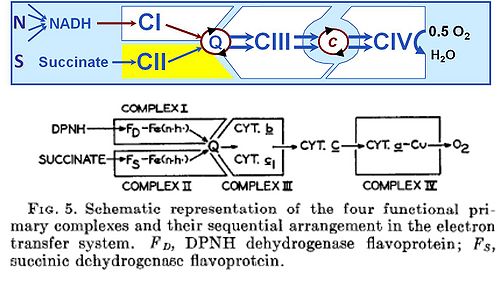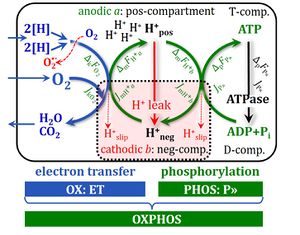Difference between revisions of "Electron transfer pathway"
| Line 14: | Line 14: | ||
}} | }} | ||
Communicated by [[Gnaiger E]] 2010-08-17, edited 2014-07-06. | Communicated by [[Gnaiger E]] 2010-08-17, edited 2014-07-06. | ||
== | __TOC__ | ||
= TITLE = | |||
{{Publication | |||
|title=Gnaiger E (2017) TITLE. Mitochondr Physiol Network 2017-02-17. | |||
|info= | |||
|authors=OROBOROS | |||
|year=2017 | |||
|journal=MiPNet | |||
|abstract=[[File:E.jpg]] Measurement of '''ETS capacity''' in the noncoupled state at optimum [[uncoupler]] concentration does not represent a general substitute for determination of [[OXPHOS capacity]] (compare [[State 3]]). If the ratio of OXPHOS/ETS capacity ([[OXPHOS control ratio |''P/E'' ratio]]) is less than one, noncoupled respiration overestimates the apparent reserve capacity for oxidative phosphorylation with respect to [[ROUTINE respiration]] of intact cells. The conditions for measurement and expression of respiration vary ([[oxygen flux]] in state ''E'', ''J''<sub>O2''E''</sub> or [[oxygen flow]] in state ''E'', ''I''<sub>O2''E''</sub>). If these conditions are defined and remain consistent within a given context, then the simple symbol ''E'' for respiratory state is used to substitute the more explicit expression for respiratory activity. In state ''E'', the [[mt-membrane potential]] is almost fully collapsed and provides a reference state for [[flux control ratio]]s. | |||
|mipnetlab=AT Innsbruck Gnaiger E | |||
}} | |||
{{Labeling | |||
|couplingstates=ETS | |||
|instruments=Theory | |||
}} | |||
[[File:Hatefi 1962 NS 2012.jpg|right|500px|Q-junction]] | |||
== Electron transfer system versus electron transport chain == | |||
:::: The well established terms 'respiratory chain' or 'electron transfer chain' suggest erroneously that the convergent '''electron transfer system''' may be designed as a simple ''chain''. But the term '''electron transport chain''' (or electron transfer chain, ETC) is a misnomer. Understanding mitochondrial respiratory control has suffered greatly from this inappropriate terminology, although textbooks using the term ETC (Lehninger 1970) make it sufficiently clear that '''electron transfer systems are not arranged as a chain''': the „ETC‟ is in fact not a simple chain but an arrangement of electron transfer complexes in a non-linear, convergent electron transfer system. The classically introduced term '''electron transfer system''' (Hatefi et al 1962) is accurate and sufficient (IUB 1991). | |||
:::: The established convention of defining the 'electron transport chain' as being comprised of four Complexes has conceptual weaknesses. | |||
:::: (a) In fact, there are at least six Complexes of mitochondrial electron transfer: In addition to Complexes I and II, [[glycerophosphate dehydrogenase complex]] (CGpDH) and [[electron-transferring flavoprotein complex]] (CETF) are involved in the [[Q-junction]] with electron transfer to [[Complex III]] (IUB 1991, Gnaiger 2014). | |||
:::: (b) The term „chain‟ suggests a linear sequence, whereas the functional structure of the electron transfer system can only be understood by recognizing '''the convergence of electron flow at the Q-junction''', followed by a chain of Complexes III and IV, mediated by [[cytochrome c | cytochrome ''c'']] (Gnaiger 2014). | |||
:::: Electrons flow to oxygen from either [[Complex I]] with a total of three coupling sites, or from [[Complex II]] and other flavoproteins, providing multiple entries into the Q-cycle with two coupling sites downstream (Gnaiger 2014). | |||
== Electron transfer versus transport == | |||
:::: Electron transfer and electron transport are used synonymously. A general distinction, however, may be helpful: | |||
:::: (i) '''Transfer''' (inter- or intramolecular) of a reactant involves a chemical reaction. | |||
:::: (ii) '''Transport''' (from one place to another) of an entity is a (vectorial) process in contrast to a chemical reaction (IUPAC Green Book). | |||
== Related terms in Bioblast == | == Related terms in Bioblast == | ||
Revision as of 09:33, 17 February 2017
Description
![]() The mitochondrial electron transfer system (ETS; synonymous with 'electron transport system') transfers electrons from externally supplied reduced substrates to oxygen. It consists of the membrane-bound ETS (mETS) with enzyme complexes located in the inner mt-membrane, mt-matrix dehydrogenases generating NADH, and the transport systems involved in metabolite exchange across the mt-membranes (see ETS capacity).
The mitochondrial electron transfer system (ETS; synonymous with 'electron transport system') transfers electrons from externally supplied reduced substrates to oxygen. It consists of the membrane-bound ETS (mETS) with enzyme complexes located in the inner mt-membrane, mt-matrix dehydrogenases generating NADH, and the transport systems involved in metabolite exchange across the mt-membranes (see ETS capacity).
Abbreviation: ETS
Reference: Gnaiger 2009 Int J Biochem Cell Biol, ETS capacity
MitoPedia concepts:
Respiratory state,
Recommended
MitoPedia methods:
Respirometry
MitoPedia topics:
Enzyme,
EAGLE
Communicated by Gnaiger E 2010-08-17, edited 2014-07-06.
TITLE
| Gnaiger E (2017) TITLE. Mitochondr Physiol Network 2017-02-17. |
Abstract: ![]() Measurement of ETS capacity in the noncoupled state at optimum uncoupler concentration does not represent a general substitute for determination of OXPHOS capacity (compare State 3). If the ratio of OXPHOS/ETS capacity (P/E ratio) is less than one, noncoupled respiration overestimates the apparent reserve capacity for oxidative phosphorylation with respect to ROUTINE respiration of intact cells. The conditions for measurement and expression of respiration vary (oxygen flux in state E, JO2E or oxygen flow in state E, IO2E). If these conditions are defined and remain consistent within a given context, then the simple symbol E for respiratory state is used to substitute the more explicit expression for respiratory activity. In state E, the mt-membrane potential is almost fully collapsed and provides a reference state for flux control ratios.
Measurement of ETS capacity in the noncoupled state at optimum uncoupler concentration does not represent a general substitute for determination of OXPHOS capacity (compare State 3). If the ratio of OXPHOS/ETS capacity (P/E ratio) is less than one, noncoupled respiration overestimates the apparent reserve capacity for oxidative phosphorylation with respect to ROUTINE respiration of intact cells. The conditions for measurement and expression of respiration vary (oxygen flux in state E, JO2E or oxygen flow in state E, IO2E). If these conditions are defined and remain consistent within a given context, then the simple symbol E for respiratory state is used to substitute the more explicit expression for respiratory activity. In state E, the mt-membrane potential is almost fully collapsed and provides a reference state for flux control ratios.
• O2k-Network Lab: AT Innsbruck Gnaiger E
Labels:
Coupling state: ETS"ETS" is not in the list (LEAK, ROUTINE, OXPHOS, ET) of allowed values for the "Coupling states" property.
HRR: Theory
Electron transfer system versus electron transport chain
- The well established terms 'respiratory chain' or 'electron transfer chain' suggest erroneously that the convergent electron transfer system may be designed as a simple chain. But the term electron transport chain (or electron transfer chain, ETC) is a misnomer. Understanding mitochondrial respiratory control has suffered greatly from this inappropriate terminology, although textbooks using the term ETC (Lehninger 1970) make it sufficiently clear that electron transfer systems are not arranged as a chain: the „ETC‟ is in fact not a simple chain but an arrangement of electron transfer complexes in a non-linear, convergent electron transfer system. The classically introduced term electron transfer system (Hatefi et al 1962) is accurate and sufficient (IUB 1991).
- The established convention of defining the 'electron transport chain' as being comprised of four Complexes has conceptual weaknesses.
- (a) In fact, there are at least six Complexes of mitochondrial electron transfer: In addition to Complexes I and II, glycerophosphate dehydrogenase complex (CGpDH) and electron-transferring flavoprotein complex (CETF) are involved in the Q-junction with electron transfer to Complex III (IUB 1991, Gnaiger 2014).
- (b) The term „chain‟ suggests a linear sequence, whereas the functional structure of the electron transfer system can only be understood by recognizing the convergence of electron flow at the Q-junction, followed by a chain of Complexes III and IV, mediated by cytochrome c (Gnaiger 2014).
- Electrons flow to oxygen from either Complex I with a total of three coupling sites, or from Complex II and other flavoproteins, providing multiple entries into the Q-cycle with two coupling sites downstream (Gnaiger 2014).
Electron transfer versus transport
- Electron transfer and electron transport are used synonymously. A general distinction, however, may be helpful:
- (i) Transfer (inter- or intramolecular) of a reactant involves a chemical reaction.
- (ii) Transport (from one place to another) of an entity is a (vectorial) process in contrast to a chemical reaction (IUPAC Green Book).
Related terms in Bioblast
![]() OXPHOS, P
OXPHOS, P
![]() ROUTINE, R
ROUTINE, R
![]() ETS, E
ETS, E
![]() LEAK, L
LEAK, L
 ROX, R
ROX, R



